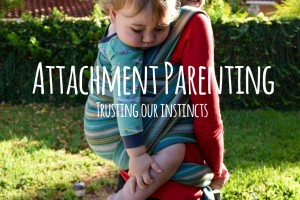When I was pregnant with Dominik, I knew that there was a certain way that I wanted to raise him. I’m already a pretty crunchy person, so I wanted my parenting to reflect a more natural, more gentle way of life. More importantly, I wanted to raise him to be kind, gentle, and to have empathy towards others. It was then that I came across the term attachment parenting.
Being certified in Early Childhood Education, I have taken many child development and psychology classes. Attachment parenting comes from the attachment theory in developmental psychology. It basically says that humans have a developmental need to be attached to their caregivers early in life. This determines how they are able to connect and interact with others as they grow up into adulthood. There are different kinds of attachments, depending on the child and how the parent interacts with them. The goal of attachment parenting is secure attachment: a child that is securely attached seeks comfort from their caregiver and is upset when their caregiver leaves, but with them around feels safe enough to explore. Children that are securely attached typically grow into adults with higher self-esteem that are better equipped to build healthy relationships.
Especially recently, leaders in these fields are really highlighting the importance of things that create attachment like breastfeeding, co-sleeping, responding to a child’s needs, and using gentle parenting methods. In general, the days of experts recommending that parents not “spoil” their child by picking them up too often are long gone. The evidence is now supporting the fact that children need gentle, nurturing love to grow into kind, empathetic, and connected adults.
But the great thing about attachment parenting, is that it’s not anything new or fancy. In fact, it’s all about instincts and returning to what our biology dictates. But to give a better idea on what these instincts are telling us, there are a series of 7 flexible characteristics of attachment parenting:
- The importance of bonding after birth.
The minutes after birth are incredibly significant for both mother and child. The mother has a wonderful concoction of love hormones flowing that help attach her to her child. This euphoric love is intense and is biologically imperative to an infant’s survival. A newborn’s instinct right after birth is to eat and find their mother. Skin to skin contact regulates breathing, heart rate, and body temperature. This is especially important because the baby is going from a safe, dark, warm environment, to somewhere bright, cold, and scary. Born with the instinct to suck, the sooner breastfeeding is established, the more likely that the breastfeeding relationship will continue to be successful. Staying close to mom hours after birth will help to keep up this responsive relationship.
2. Breastfeeding, if possible, is best.
There are situations where breastfeeding is not possible, and that doesn’t mean that a child cannot become attached. The idea is that holding a baby close, so that they can gaze at our face during feeding, helps to promote caregiver and child attachment. It tells our baby that we are here to provide nourishment. Of course, breastfeeding has an incredibly long list of benefits to both mother and child, so breastfeeding or using donated breastmilk is the healthiest option. Extended breastfeeding, or breastfeeding past a child’s first birthday, is also encouraged. But the main idea of this category is that caregivers respond when a baby is hungry and, paying attention to their cues, stop when they are full. This practice continues into toddler and childhood as parents encourage healthy eating habits and avoid things like making a child eat everything on their plate.
3. Responding to a baby’s cries.
Babies cry. Toddlers whine. It happens and will happen often. But the attachment theory emphasizes that a child’s needs should be met with a response. When babies are cold, tired, hungry, or just want to be held, these are not wants, these are needs. The idea is that if parents respond to their children, a more healthy attachment will be created because they feel safe and secure that their needs will always be met.
4. Babywear and keep them close.
Babies and children need to be touched. There have been some unfortunate events in various parts of the world that have shown that babies will fail to thrive without human touch. By babywearing, using massage, holding, snuggling, and carrying them, the need for human touch is fulfilled. Plus, they benefit a baby physically. Babywearing helps to develop their vestibular system as they feel how you move and skin to skin contact helps them to regulate body temperature, heart rate, and breathing. Older children benefit from a nurturing touch as well and this only strengthens and maintains a secure attachment.
5. Natural sleeping habits.
In the wild, babies and children sleep close to their parents. At night, and during sleep, we are especially vulnerable, plus the needs of children do not simply stop once the sun sets. Babies do not care if it is 2 am, if they are hungry or need a snuggle or a new diaper, they will let you know. Having baby close, and responding to nighttime cues, reassures a child that their needs will be met and helps to create healthy sleep habits later in life. “Sleep training” is generally viewed as potentially detrimental to psychological development as it can leave a child to feel abandoned. Safe co-sleeping (sleeping on a firm surface with no surrounding hazards) is beneficial as baby can easily get breastmilk and their breathing and heart rate stay regular because their body is regulated by ours.
6. Positive and gentle discipline.
There will come a time when that cute little baby will get into everything. Testing boundaries and breaking rules is natural for children as it is how they learn about their world and how to live in it. Parents that practice attachment parenting generally avoid corporal punishment like spanking as well as psychological punishment like shaming because they are connected to behavioral and self esteem issues later in life. Attachment parenting is about responding with understanding and helping to guide children in the right direction. Does discipline need to happen? Totally. But by helping children to understand why they cannot do certain things and responding with appropriate consequences, they will be more likely to handle following the rules in the future. I recommend “The Whole Brain Child” by Daniel Siegel, M.D. for a more in depth look on this.
7. Listen to your instincts.
This is really the main aspect of attachment parenting. If instinct is telling you to pick up your baby, pick them up. When Dominik cries, the first thing I want to do is scoop him up into my arms, no matter why he is crying. There have been times that others have encouraged me to ignore what my heart and soul are saying. We once had a pediatrician (not our own) tell us that we had to let him cry himself to sleep, even if it took hours. There is a reason why a babies cries are so emotionally jarring for parents. Our biology and instincts have made sure that the next generation will survive and thrive.
Looking back to my own childhood, I see that my mother implemented these practices in her own parenting. As an adult who is still very close with her mother, I feel appreciative that she always responded with love and patience. I know that my own parenting will never be perfect, and there have already been plenty of moments when I had thought like, “maybe I should just let him cry to sleep…I’m just so tired!” or times when I wanted to yell because he had just thrown something else into the toilet. But I hope, that with just a lot of love and trust in myself, that Dominik will grow up feeling loved and like he is ready for the world.





